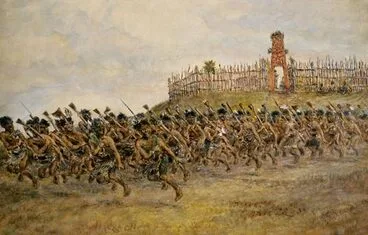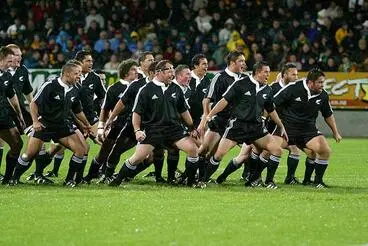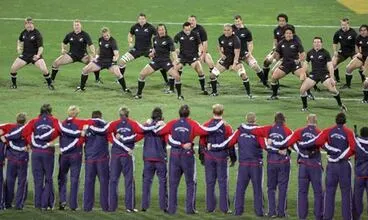The haka and rugby culture in New Zealand
A DigitalNZ Story by Eden
Maori Batallion members performing a vigorous haka in Egypt.
Members of the Maori Battalion performing a haka, Maadi, Egypt
Alexander Turnbull Library
A painting of a “Peruperu” haka being performed for battle.
Haka
Manatū Taonga, the Ministry for Culture and Heritage
Two defining aspects of New Zealand culture are the haka dance, and the sport of rugby. The haka is an ancient tradition and the sport of rugby is one way the country gives the haka a platform today. Both of these practices are expressions of kiwi culture, confirming traditional depictions of battle and the attitude behind fighting for survival.
The haka is one of the oldest, most captivating and unique expressions of New Zealand culture. It is an ancient Maori ritual, originally performed during war to intimidate the opponent or during peaceful ceremonies. The haka is normally performed primarily by men, while women participate in a separate haka or part of the chorus. One Maori legend says that the haka came from Ra, the sun god. The quivering of the hands during the dance represents Ra’s son, Tane-roe, dancing in the sunlight for his mother, Hine-raumati (Cunningham, 2018).
During a haka, performers create a fierce display of tongue protrusions, bulging eyes, foot stomping and chest slapping along with chanting. It is believed that the dancer should use their entire body to speak for the message intended to be conveyed during a performance. Each haka tells a different story and is specific to the ones receiving the performance. For example, when New Zealand Defence Forces lost a soldier, there would be a specific haka for that soldier (McDougal 2018 pg. 64). The haka is a spiritual and soulful dance that evokes emotion in viewers whether they are Maori or not. The haka represents kiwi culture in a highly respected, beautiful way.
The All Blacks rugby team is part of the heart of New Zealand culture, and brings attention to the power of haka.
Haka
Manatū Taonga, the Ministry for Culture and Heritage
One of the two types of war hakas was called “Peruperu,” which included weapons, whereas the “Haka Taparahi” is performed without weapons. The haka called “Ka Mate” was composed by Ngati Toa, tribal Chieftain Te Rauparaha in 1820 and is now one of the most well-known haka’s. “Ka Mate” represents Rauparaha’s resilience as a survivor of the mass killing of his Maori people (Baxter, Lloyd and Wyse, 2015). It comes from overcoming adversity and having triumph for life over death.
The haka is used to tell many stories such as triumph, grievance or as a prayer to a Maori God. It is also performed when two communities meet or as a welcoming for visitors (Penny, Gram 2014 pg. 43). The haka is still used throughout many celebrations and ceremonies in New Zealand such as birthdays, sports, weddings and funerals. For example, Respectfully, anyone can learn the haka, as Maori culture is one of the most welcoming and inclusive cultures. Maori people are known for their kindness and willingness to share their heritage to the rest of the community and visitors.
Today, most people may know of the haka through the New Zealand rugby team, called the All Blacks. In 1905 the ‘original’ All Blacks team performed the haka, “Ka Mate” and the current All Blacks team famously performs “Ka Mate” as well (Team All Blacks, 2018). The crowd chants with the team as they challenge their opponent before a match. It is an intimidating and sometimes shocking experience for the opponent. Rugby opens outsider’s eyes to the deep tribal roots of New Zealand culture through the teams haka and their passion in the way they play. The team includes members from different cultures outside of Maori or New Zealand and their haka unites them all.
Most kiwi children learn the basics of rugby in their first years of primary school.
Photographs relating to Marist Rugby League Club, Greymouth
Alexander Turnbull Library
The All Blacks are ranked as the top rugby team in the world. Their wins have equally as much to do with their energy, and intelligence towards the game as their physical effort going into training (Dymock, 2018). The team has a never-say-die attitude and has shone to consistently put their all into each match. The evolution of men from warriors performing a haka, then fighting, to rugby players performing then playing is clear. In a sense, New Zealand has basically been breeding some of the best athletes in the world for centuries. Since New Zealand has such a dense history of war and physically fighting for their lives, it is engrained in players to treat the game with the same vigor and attitude.
Rugby is a huge aspect to New Zealand culture in which the nation identifies with. It is said that most kiwi children learn the basics of rugby in their first years of primary school (Coates, 2018). The sport is a huge developmental component to kids learning and integrity. Rugby gives kids a place to play around freely outside, learn about discipline, handling pressure, and how to have pride in something bigger than themselves. It gives them something to represent their school or community with and overall connect them to their roots. To many kiwis, rugby means everything.
Rugby has influenced the identity and nationality of New Zealand significantly. For example, on the making of the rugby documentary called ‘Beneath the Black’, James Gemmell states: "It really wasn't that much about rugby on the pitch, this was about our relationship with rugby and how it's shaped us as a country, so we looked at those big themes, and we tried to find specific examples within New Zealand culture and society as a means of showcasing it" (Dickens 2017).
Each haka is different and there are many different reasons for a haka to be performed. Here is a haka ceremony at night
A night haka
Museum of New Zealand Te Papa Tongarewa
Rousing B Coy haka, Rotorua
Manatū Taonga, the Ministry for Culture and Heritage
The All Blacks are ranked as the top rugby team in the world. Their wins have equally as much to do with their energy, and intelligence towards the game as their physical effort going into training (Dymock, 2018). The team has a never-say-die attitude and has shone to consistently put their all into each match. The evolution of men from warriors performing a haka, then fighting, to rugby players performing then playing is clear. In a sense, New Zealand has basically been breeding some of the best athletes in the world for centuries. Since New Zealand has such a dense history of war and physically fighting for their lives, it is engrained in players to treat the game with the same vigor and attitude.
Rugby is a huge aspect to New Zealand culture in which the nation identifies with. It is said that most kiwi children learn the basics of rugby in their first years of primary school (Coates, 2018). The sport is a huge developmental component to kids learning and integrity. Rugby gives kids a place to play around freely outside, learn about discipline, handling pressure, and how to have pride in something bigger than themselves. It gives them something to represent their school or community with and overall connect them to their roots. To many kiwis, rugby means everything.
Rugby has influenced the identity and nationality of New Zealand significantly. For example, on the making of the rugby documentary called ‘Beneath the Black’, James Gemmell states: "It really wasn't that much about rugby on the pitch, this was about our relationship with rugby and how it's shaped us as a country, so we looked at those big themes, and we tried to find specific examples within New Zealand culture and society as a means of showcasing it" (Dickens 2017).
Kapa haka group
Manatū Taonga, the Ministry for Culture and Heritage
The All Blacks dominating during their tour of the British Isles, France and the United States.
All Blacks in action
Manatū Taonga, the Ministry for Culture and Heritage
Both the haka, and the sport of rugby draw deep connection through New Zealand, uniting the nation in the most powerful way. Nowhere else in the world identifies more with the sport of rugby, nor the ancestry of the haka. The haka confirms kiwi culture as a passionate, dedicated and uplifting society. It is a vehicle for social messages, as well as tributes, setting the All Blacks apart from any other team in history. The haka and rugby depict kiwi culture as strong, real, caring and united people.
The All Blacks perform a powerful haka before a match
All Black haka
Manatū Taonga, the Ministry for Culture and Heritage
Baxter, Ryan. Lloyd, Chris. Wyse, Pascal. The Surprising History of the Haka: it’s Not Just the All Blacks’ War Dance-Video
https://www.theguardian.com/sport/video/2015/sep/11/history-haka-all-blacks-new-zealand-rugby-video
Coates, Joe. Why New Zealand Dominates Global Rugby https://theculturetrip.com/pacific/new-zealand/articles/why-new-zealand-dominates-global-rugby/
Cunningham, John M. Haka Maori Dance https://www.britannica.com/art/haka
Dickens, Andrew. The Reason Why Rugby is so Important in New Zealand https://www.nzherald.co.nz/sport/news/article.cfm?c_id=4&objectid=11935647
Dymock, Alan. Why are the All Blacks so Good https://edition.cnn.com/2018/07/18/sport/new-zealand-rugby-all-blacks-rugby-world-cup/index.html
McDougall, Hamish. “The Whole World’s Watching’:New Zealand, International Opinion, and the 1981 Springbook Rugby Tour”. University of Illinois Press, 2018.
Penny, H. Glenn. Graham, Laura R. “Performing Indigeneity : Global Histories and Contemporary Experiences”. UNP-Nebraska, 2014.








